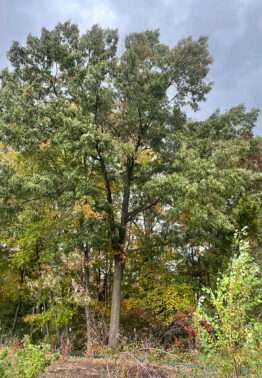Southern Red Oak
Researched by Luke Castagna
 Species: Quercus falcata
Species: Quercus falcataCommon name: Southern Red Oak, Spanish Oak, Bottomland Red Oak, Three-lobed Red Oak
Family: Fagaceae (Oak Family)
Clade: Angiosperms (flowering seed plants)
Coordinates: 39.7088622, -75.11497813
A tag using this number is placed near the tree.
Quercus falcata, commonly known as the southern red oak, is part of the larger family of plants known as beech or Fagaceae. This species is thought to have evolved some 56 million years ago and is native to the United States. They grow from New Jersey to Florida and west to Texas. The southern red oak, also called the Spanish oak, was discovered where the first Spanish colonies in the Americas were founded. This species thrives in moisture-rich environments where there are seasonal temperatures. That is why the species only grows within the temperate forest biome of the United States. The species can grow fairly large, towering over 90 feet, with a trunk circumference of nearly 27 feet.
Like many tree species in the New Jersey area, the southern red oak is deciduous, meaning the leaves fall off and regrow seasonally – a common characteristic of trees in the temperate zones. Because of this, during the fall months, the southern red oak’s leaves will turn red and droop until they fall off. The simple leaves of a southern red oak are very distinguishable. They grow in an alternate arrangement in the stem and have pinnate leaf venation, which means veins branch off from the central mid-vein in a parallel fashion toward the margin, or edge, of the leaf. The leaves are lobed, with three to five, a common feature of oak species. This particular oak has pointed lobes, characteristic of the larger group of red oaks, whereas white oaks have rounded leaf lobes. The southern red oak can also be identified by its characteristic dark gray straight trunk with deep grooves between the bark. Read More
Campus Species Map
Researcher’s Biography
 Luke Castagna
Luke Castagna
Luke Castagna earned a Bachelor of Science in Biological Sciences from Rowan in 2022.
Suggested Citation:
Castagna, Luke. (2022, Dec). Southern Red Oak. Rowan University Arboretum. https://arboretum.rowan.edu/trees/southern-red-oak/
Questions to Explore
- Why are southern red oaks not found in other regions around the world that are in temperate forest biomes?
- Why does it take so long for the southern red oak to produce fruit?
- Why does it take 2 years for the acorns to mature?
References
Belanger R. P. (unknown date). Southern Red Oak, Quercus falcata michx. USDA Southern Research Station. | Link.
Chotikhun, A., & Hiziroglu, S. (2016). Measurement of dimensional stability of heat-treated southern red oak (Quercus falcata Michx.). Measurement, Volume 87, 99-103. | Link
MDC staff. (unknown date). Southern Red Oak (Spanish Oak). Missouri Department of Conservation. | Link
The Wildflower Center Staff. (2015). Quercus falcata. The University of Texas at Austin Wildflower Center. | Link
Varma, Y., & Tran, M. (2015). Southern Red Oak. Glen Arboretum, Towson University. | Link
Additional Resources
You may need to sign into the Rowan University Library website.
Biological Responses of Red Oaks and Willow Oak to Hypoxia in the Rhizosphere | Link
Oaks were the historical foundation genus of the eastern-central United States | Link
How fast and far might tree species migrate in the eastern United States due to climate change? | Link



















